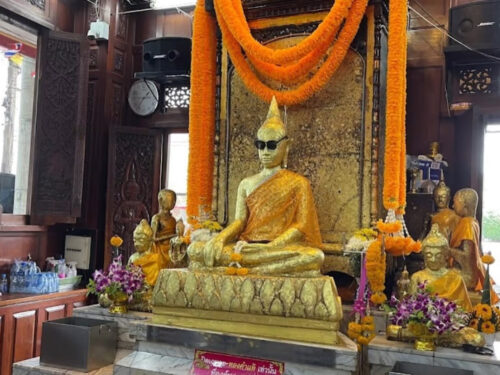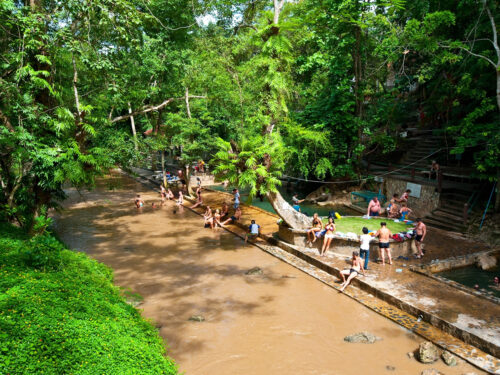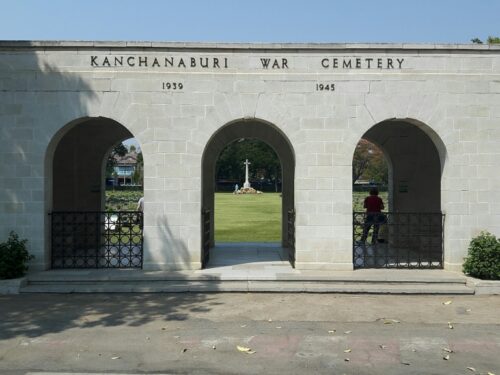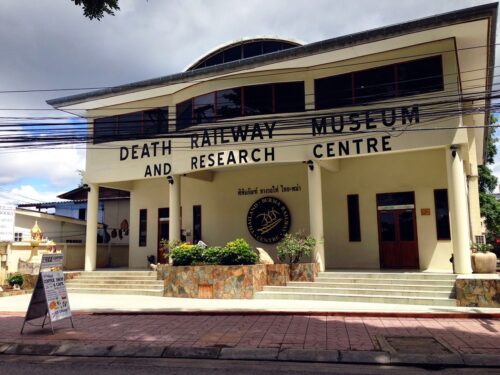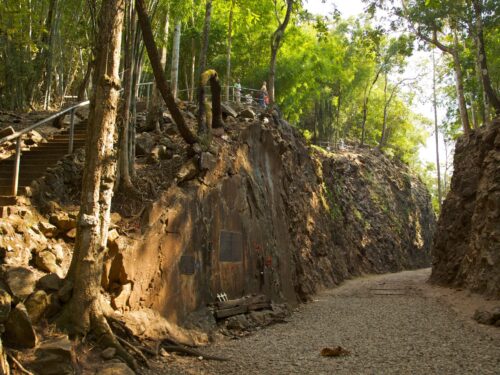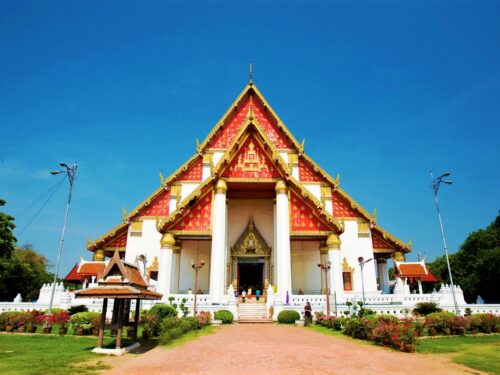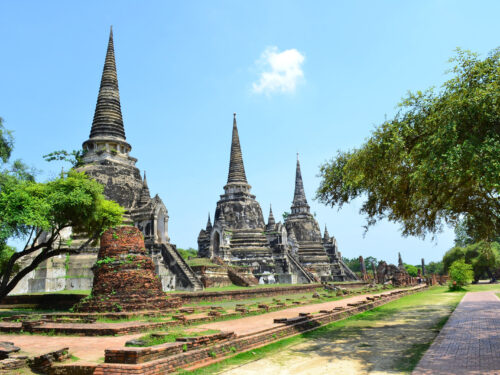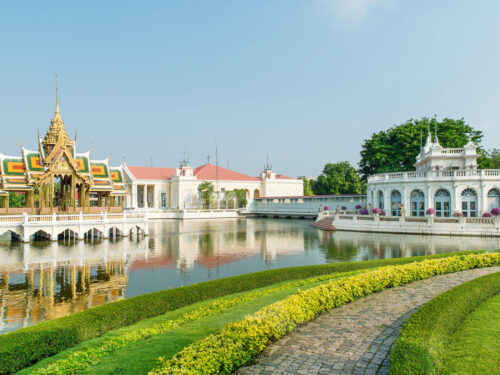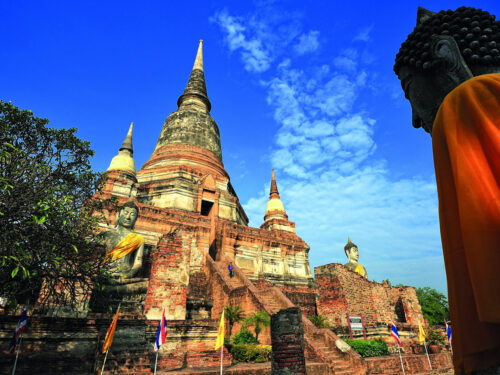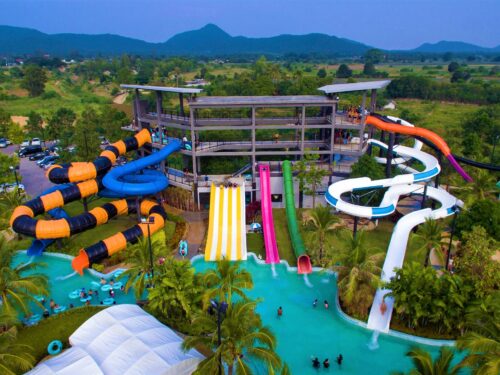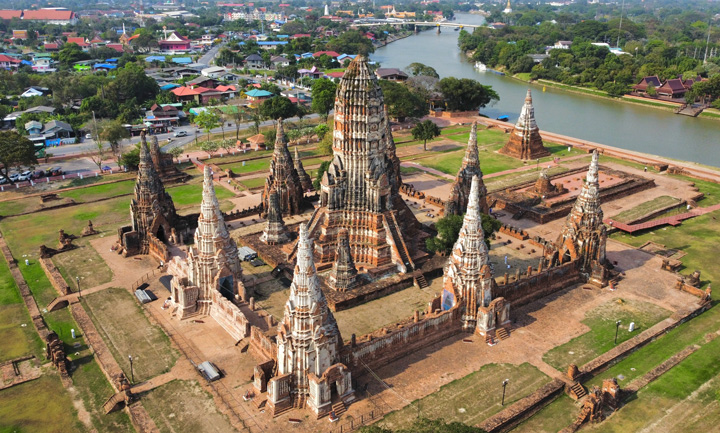Wat Chaiwatthanaram, Ayutthaya
Situated amidst the historical city of Ayutthaya, Wat Chaiwatthanaram stands as a testament to Thailand’s splendid past.
Its meticulously crafted design and exquisite details reflect the harmonious fusion of Hindu and Buddhist artistic traditions. The temple’s architecture is a sight to behold, featuring ornate towers, meticulously carved facades, and a mesmerizing array of decorative elements.
History of Wat Chaiwatthanaram
In 1630, King Prasat Thong commissioned the construction of Wat Chaiwatthanaram, an architectural marvel that stood as one of the most magnificent monuments in the Ayutthaya Kingdom.
Firstly, King Prasat Thong sought to accumulate Buddhist merit through its construction. Secondly, he intended for the temple to serve as a memorial for his beloved mother. To honor her memory, two square chedis were built on the eastern side of the temple, where her ashes were enshrined.
Interestingly, during excavations at the site, archaeologists uncovered canon balls and canons, suggesting that the temple may have served as a fortified structure during the final conflict with Burma. This indicates its potential dual function as both a religious sanctuary and a defensive stronghold.
Tragically, in 1767, the Burmese armies looted and extensively devastated the monastery, causing it to be abandoned. The temple fell into a state of ruin and remained neglected for many years. However, during the late 1980s and early 1990s, the Fine Arts Department took up the task of restoring Wat Chaiwatthanaram to its former glory.
Architecture of Wat Chaiwatthanaram
Wat Chaiwatthanaram’s construction drew inspiration from the architectural principles of the Khmer mountain temples of Angkor, which aimed to represent the cosmos according to Buddhist and Hindu cosmology.
The monastery was enclosed by a protective wall measuring approximately one meter in width. The wall featured arched gateways that provided access to the temple complex. The primary entrance faced east, offering a direct view towards the majestic Chao Phraya River.
Notably, the King would arrive at the monastery by boat, utilizing the river as a means of transportation. To facilitate his access to the monastery, a designated boat landing was established, enabling the King to disembark and enter the temple grounds.
Central Khmer-style prang
Situated at the heart of Wat Chaiwatthanaram, there is a 35-meter-tall Khmer style prang, characterized by its corncob shape, positioned on a raised brick platform. Complementing the grandeur of the prang, smaller towers grace each corner. Symbolically, the prang represents Mount Meru, a significant mountain in Hindu and Buddhist cosmology, symbolizing the central point of the universe surrounded by vast oceans.
To access the prang, steep stairways are located at each of the four cardinal directions. Notably, the eastern stairway leads to an inner chamber known as the cella or crypt. Within this sacred space, relics and precious artifacts were reverently enshrined, amplifying the sanctity and spiritual significance of the temple.
Galleries around the main prang
Encircling the main platform that supports the central prang, a series of eight smaller chedis are connected by covered galleries, forming a courtyard. These slender towers, standing at a height of 25 meters, gradually decrease in size as they ascend. Within each tower’s interior, niches house Buddha images seated on pedestals.
The eight chedis are adorned with intricate reliefs that depict the Jataka tales, stories narrating the previous lives of the Buddha. During that era when literacy was limited, these pictorial representations served as a means to convey the teachings of the Buddha.
Along the gallery, over 100 gilded and black lacquered images of the Buddha, depicted in the subduing Mara mudra, are positioned. While the walls, adorned with false windows, still remain intact, the wooden roof that once sheltered the area has long vanished.
Other structures
Located to the east of the central prang, towards the river, is the ubosot, a hall where novices undergo ordination to become monks. Today, only the foundation and the main altar, housing two seated Buddha images, still remain. Flanking the ubosot are two chedis that serve as the final resting place for the ashes of King Prasat Thong’s mother.
Regrettably, the likely wooden kuti, which once served as living quarters for the monks, has completely vanished over time, leaving no traces of its existence.
Location
Located on the western bank of the Chao Phraya River, Wat Chaiwatthanaram resides in the southwestern region of the historic Ayutthaya Kingdom. Although it is not officially included as part of the UNESCO World Heritage Site, the temple can be found within the premises of the Ayutthaya Historical Park, contributing to the rich cultural heritage of the area.
Opening Hours
Visitors can explore Wat Chaiwatthanaram daily from 8 AM to 5 PM.
Entrance fee
The admission fee per person for Wat Chaiwatthanaram is 50 Thai Baht.
Tips for travelers
- Dress Code: As Wat Chaiwatthanaram is a religious site, it’s important to dress respectfully. Make sure to wear modest clothing that covers your shoulders, knees, and ankles. This shows respect for the sacredness of the temple and is also required for entry.
- Sun Protection: Ayutthaya can get quite hot, especially during the day. Remember to bring sunscreen, a hat, and sunglasses to protect yourself from the sun’s rays. It’s also a good idea to carry a bottle of water to stay hydrated.
- Footwear: You’ll be required to remove your shoes before entering the main temple area. Consider wearing shoes that are easy to slip on and off, such as sandals or flip-flops, to make the process more convenient.
- Guided Tours: Consider joining a guided tour or hiring a local guide who can provide valuable insights into the temple’s history, architecture, and cultural significance. They can enhance your overall experience and provide you with a deeper understanding of the site.
As one of the highlights of Ayutthaya, Wat Chaiwatthanaram is a testament to the grandeur of the Ayutthayan era. It serves as a reminder of the kingdom’s cultural and spiritual significance, and visiting this historic site allows travelers to connect with Thailand’s past and immerse themselves in its rich heritage.
Tourists’ Reviews
Let’s see what others are saying about Wat Chaiwatthanaram on TripAdvisor:
boaster
The sunset spot
Jan 2023 • Couples
Everyone goes here for late afternoon and sunset. Many Thais dressed in traditional clothing were here when we visited which makes for an interesting addition. Look out for bats in the inside of the buildings as they leave their resting space at sunset. One of the stupas is currently being restored but it does not interfere with the sunset view.
James A
Large open grounds temple
Jun 2022
Just outside the central island lies this beauty of a temple with fairly intact Khmer architecture. 50Baht entry gets you access to large open grounds with stupas, buddha statues, a main prang and a altar with steps.
At my time of visit one part was off limits due to restoration but it didn’t affect the experience or the amazing photo opportunities. If you’re staying on the island i’d suggest renting a bike or tuk tuk to get to this one as it’s hard to deal with in the heat.
There are shady parts inside the main citadel but its still hot. Take a hat. The less explored open ground the far side would be excellent for sunset or sunrise.
It’s well worth a visit for a temple explorer as a solo venue or part of the 220Baht multi temple ticket available.
Food and light shopping is just over the road if needed. Large car park and bike locks just outside the ticket booth.
Other attractions
